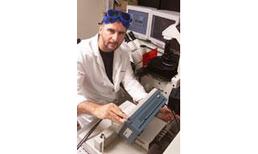Seminar 11th October 2011 2 p.m. University of Southampton, Building 85 (Life Sciences) Room 2209
Visualising molecular cell biology: theoretical and experimental approaches with some nano solutions
Professor Paul O'Shea
Cell Biophysics Group, School of Biology, University of Nottingham and Director of the Institute of Biophysics, Imaging & Optical Science [iBIOS]
- Web page
- http://www.nottingham.ac.uk/biology/people/Paul.Oshea
- Categories
- AMBER, Biomechanics, Complex Systems, Computer Science, Design, e-Research, Education, FFT, Fortran, HPC, Iridis, Multi-physics, Multi-scale, Multigrid solvers, Quantum Chemistry, Scientific Computing, Software Engineering
- Submitter
- Chris-Kriton Skylaris
Abstract
This presentation will outline the kinds of cell biology questions that must be framed if we are to develop a rational understanding of how living cells function. Thus the extremely concentrated levels of macromolecules in the cellular interior complicates molecular modelling. Similarly, experimentally visualising the molecular properties of living cells presents many formidable problems; in some cases it even seems necessary to breach the laws of physics. The most obvious of these relates to the need to explore cells with a spatial resolution that is beyond the diffraction limit of visible light and introduced a series of ‘super-resolution’ techniques (several of these are discussed in O’Shea et al 2008).
I will outline some of the theoretical and experimental approaches we are taking to address some of these questions. Some broad examples will be used to illustrate several of the problems in more detail, some developments in live cell imaging and array-technologies for the so-called cellular ‘omics’ technologies will be described. Each of these will be considered from the point of view of using label-free approaches (see eg Davis et al 2011) although I will also mention the uses of novel (fluorescent) labels and their rational design and characterisation (see eg Robinson et al 2011). I will outline some of our research that involves the use of nanoplasmonics (eg Richens et al 2010) as tools to measure a broad range of important cell biological properties.
References
Davis, B.M, Richens, J. & O'Shea, P. (2011) Label-Free Critical Micelle Concentration Determination of Bacterial Quorum Sensing Molecules Biophysical Journal, 101: 245-254.
O'Shea, P., Somekh, M.G. & Barnes, W.L. (2008) Shedding light on life; visualising nature's complexity. Physics World. 21: 29-34
Richens, J., Weightman, P., Barnes, W.L. & O’Shea, P. (2010) In vivo spectroscopic imaging of biological membranes & surface imaging for high-throughput screening. In Nanoscopy & Multidemsional Optical fluorescence Mircoscopy. A Diaspro et al (Ed). Taylor & Francis CRC Press, USA
Robinson, D., Besley. N. A., O’Shea, P. & J. D. Hirst (2011) Di-8-ANEPPS emission spectra in phospholipid/ cholesterol membranes: A theoretical study. Journal of Physical Chemistry B, 115 : 4160–4167
Contact
Professor Jonathan Essex
http://www.soton.ac.uk/chemistry/about/staff/jwe1.page
